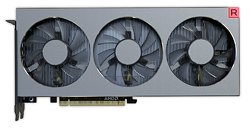- Joined
- Oct 9, 2007
- Messages
- 47,222 (7.55/day)
- Location
- Hyderabad, India
| System Name | RBMK-1000 |
|---|---|
| Processor | AMD Ryzen 7 5700G |
| Motherboard | ASUS ROG Strix B450-E Gaming |
| Cooling | DeepCool Gammax L240 V2 |
| Memory | 2x 8GB G.Skill Sniper X |
| Video Card(s) | Palit GeForce RTX 2080 SUPER GameRock |
| Storage | Western Digital Black NVMe 512GB |
| Display(s) | BenQ 1440p 60 Hz 27-inch |
| Case | Corsair Carbide 100R |
| Audio Device(s) | ASUS SupremeFX S1220A |
| Power Supply | Cooler Master MWE Gold 650W |
| Mouse | ASUS ROG Strix Impact |
| Keyboard | Gamdias Hermes E2 |
| Software | Windows 11 Pro |
AMD has reportedly discontinued production of its flagship Radeon VII graphics card. According to a Cowcotland report, AMD no longer finds it viable to produce and sell the Radeon VII at prices competitive to NVIDIA's RTX 2080, especially when its latest Radeon RX 5700 XT performs within 5-12 percent of the Radeon VII at less than half its price. AMD probably expects custom-design RX 5700 XT cards to narrow the gap even more. The RX 5700 XT has a much lesser BOM (bill of materials) cost compared to the Radeon VII, due to the simplicity of its ASIC, a conventional GDDR6 memory setup, and far lighter electrical requirements.
In stark contrast to the RX 5700 XT, the Radeon VII is based on a complex MCM (multi-chip module) that has not just a 7 nm GPU die, but also four 32 Gbit HBM2 stacks, and a silicon interposer. It also has much steeper VRM requirements. Making matters worse is the now-obsolete "Vega" architecture it's based on, which loses big time against "Navi" at performance/Watt. The future of AMD's high-end VGA lineup is uncertain. Looking at the way "Navi" comes close to performance/Watt parity with NVIDIA on the RX 5700, AMD may be tempted to design a larger GPU die based on "Navi," with a conventional GDDR6-based memory sub-system, to take another swing at NVIDIA's high-end.

View at TechPowerUp Main Site
In stark contrast to the RX 5700 XT, the Radeon VII is based on a complex MCM (multi-chip module) that has not just a 7 nm GPU die, but also four 32 Gbit HBM2 stacks, and a silicon interposer. It also has much steeper VRM requirements. Making matters worse is the now-obsolete "Vega" architecture it's based on, which loses big time against "Navi" at performance/Watt. The future of AMD's high-end VGA lineup is uncertain. Looking at the way "Navi" comes close to performance/Watt parity with NVIDIA on the RX 5700, AMD may be tempted to design a larger GPU die based on "Navi," with a conventional GDDR6-based memory sub-system, to take another swing at NVIDIA's high-end.

View at TechPowerUp Main Site




 Maybe I will be changing my V64 after all. Hopefully this year. That would be great
Maybe I will be changing my V64 after all. Hopefully this year. That would be great 
